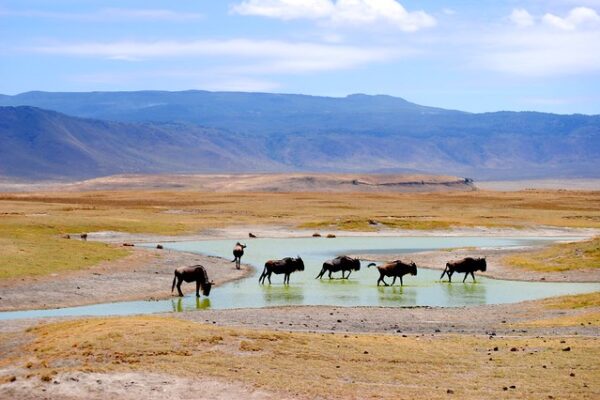
Karura Forest Under Siege?
The Friends of Karura Forest, mandated to protect and conserve the urban forest in collaboration with the Kenya Wildlife Service (KFS), has allayed concerns about illegal logging in the ecosystem.

The Friends of Karura Forest, mandated to protect and conserve the urban forest in collaboration with the Kenya Wildlife Service (KFS), has allayed concerns about illegal logging in the ecosystem.

Researchers have warned that climate change threatens the future of the Mara-Serengeti ecosystem, which includes Kenya’s Maasai Mara and Tanzania’s Serengeti National Park.

Seven years ago, Kenya imposed a ban on the manufacturing and importation of plastic carrier bags. Tens of millions of plastic bags were handed out in supermarkets every year in Kenya, polluting the environment and clogging drainage systems, which contributed to floods during the rainy seasons. Unfortunately, PET plastic bottles have now emerged as the new ‘king of trash.’ According to the United Nations Environment Programme (UNEP), every day, the equivalent of 2,000 garbage trucks full of plastic are dumped into the world’s oceans, rivers, and lakes. In Kenya, aside from polluting water bodies, PET plastic bottles are an eyesore in drainages, landfills, land, and other open grounds. UNEP adds that plastic production will increase by 40% in the next 10 years. “If we don’t do anything about the plastic soup, oceans will carry more plastic than fish (by weight) by 2050,” the United Nations warns, indicating that marine life will be irreparably destroyed. To address this global menace, James Muritu, an engineer from Kenol in Murang’a County, is producing fuel from plastic bottles through pyrolysis. Muritu, who spent over 20 years building software and hardware systems, uses locally assembled reactors to turn plastic into fuel. “The dream of producing fuel was born accidentally. Initially, I used to produce cabro paving blocks, and during the process, the plastic liquid caught fire,” Muritu said. The liquid catching fire ignited Muritu’s curiosity and got him interested in studying the chemical composition of plastic. “I learned plastics are made from hydrocarbons, and it was possible for us to produce fuel from them. Since then, I have never turned back,” he said. To produce fuel, Muritu and his partner Michael Nthenge constructed a reactor from locally available materials. He explained that he first received plastics from women, youths, and scrapyard dealers. “The large plastics are washed and shredded into small pieces before being put into a furnace, which is tightly closed to ensure it is free of oxygen,” he said. The materials are heated in two cycles determined by different temperatures, a process known as pyrolysis. Through pyrolysis, the plastic is heated to extremely high temperatures, between 300°C and 900°C, in the absence of oxygen. This causes it to break down into smaller molecules and transform into pyrolysis oil or gas. “We regulate temperatures to either come up with a petrol equivalent or a diesel equivalent. The first cycle produces heavy fuel or crude oil, and the second one refines the product,” he said. Muritu says pyrolysis is an ecologically friendly and cost-effective technology for recovering energy from waste plastic. It allows for the reuse of plastic waste as a source of energy for fuel production while also being environmentally friendly and cost-effective. “Our diesel fuel variant that’s currently sold as a diesel fuel blend has undergone rigorous tests by the Kenya Bureau of Standards and was issued a Quality Standard mark in December 2023,” he said. Since February, when production and commercialization started, Muritu has been producing 500 to 1,000 liters a day. “Our customers are farmers, boda boda riders, and a few lorry owners. It has not been easy to convince people to trust our fuel because initially, my vehicle used to stall regularly after using it,” he revealed. But after several years of research and fine-tuning the process, the quality has been ascertained, and motorists are getting value for their money. “Our prices are friendly, and those who are using the product say that it lasts longer than other fuels,” he said. Muritu revealed that, between July of last year and January of this year, they collected and used 5,770 kilograms of plastic, saving the planet from greenhouse gases.

Trashion Kenya, an initiative conceived by Habiba Abdulrahman, made its mark in Dubai on Sunday, preceding the annual celebration of Global Recycling Day on March 18th. Through captivating displays, Habiba highlighted how waste can be ingeniously repurposed into fashionable garments, challenging conventional notions of sustainability in the fashion industry.

In the past, bee stings were viewed as immunity boosters, but today’s market trends toward natural and organic products fuel a growing demand for bee venom.

The Ministry of Tourism and Wildlife has disclosed that the country receives a mere Sh 2 million from the sale of genetic resources or through bioprospecting annually.

The ongoing debate between white and red meat as the superior source of protein has been shaken up by the emergence of a new contender: black meat, embodied in the Ayam Cemani chicken breed.

While butterfly migrations are an annual event, the current migration stands out due to the sheer number of butterflies and their direction of movement. – Experts explain.

First African Climate Summit Sparks Hope Amid Global North Interference The inaugural African Climate Summit recently concluded, leaving a trail of mixed emotions among participants. While African nations remain steadfast in their commitment to phasing out fossil fuels, concerns persist over the interference of Global North powers in shaping Africa’s climate policy. Solar-Powered Dreams Despite the challenges, the summit illuminated a path forward for Africa, focusing on harnessing the continent’s abundant renewable energy potential. Solar-powered desalination plants and similar innovations are gaining momentum, offering sustainable solutions to the ongoing water scarcity crisis. Disappointment Lingers However, the summit’s official declaration fell short of expectations, mirroring the disappointments of past climate gatherings. Some critics argue that it fails to address the structural disadvantages that Africa faces in the global economy and instead perpetuates the dominance of external interests. Global North’s Influence One of the key issues raised during the summit was the role of Global North powers in shaping the agenda. Critics pointed to the presence of figures like US climate envoy John Kerry, raising questions about their involvement in discussions that were not part of the UNFCCC negotiations. Carbon Markets Controversy A major point of contention was the push for carbon markets in Africa. While some rich nations pledged funds to support these markets, concerns lingered about their effectiveness and the potential for polluting companies to benefit while local communities lose land. People’s Power Awakens Despite these challenges, the summit has had a positive impact on African climate movements. It has awakened a sense of people’s power and mobilization, marking a shift in African consciousness regarding climate change. This new awareness emphasizes the importance of prioritizing Africa’s unique renewable energy potential over carbon markets. The Fight Continues The disappointment stemming from the summit’s official declaration has only galvanized the African grassroots and people’s movements. The People’s Declaration, drafted in response to the summit’s shortcomings, outlines a vision that prioritizes structural change, community ownership, and a cleaner energy transition for Africa. Strategic Resource Battle As Africa’s critical minerals gain prominence, concerns are mounting over elite interests seeking to exploit these resources without considering environmental and social safeguards. A critical minerals plan, encompassing community ownership and Pan-African industrial planning, is seen as crucial to ensuring Africa’s strategic resources are used for domestic renewable energy production. A Glimmer of Hope Amidst the disappointment and challenges, there remains a glimmer of hope. Africa’s commitment to renewable energy, combined with the resilience of its people’s movements, paints a picture of a continent determined to rise above external interference and shape its sustainable future. The fight for climate justice in Africa continues, with the summit serving as a catalyst for change.